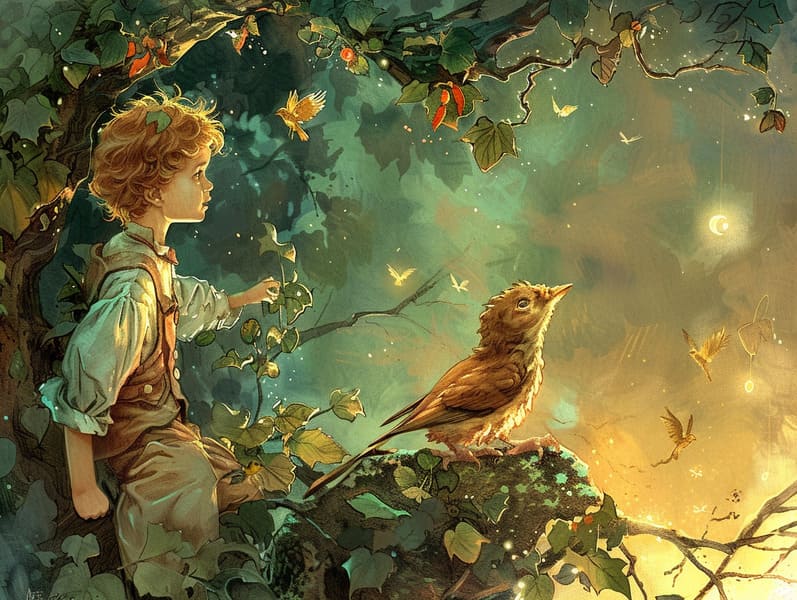
Fairy tales have historical significance. These narratives have been narrated from one generation to the next ages before they were ever documented. They were born from a variety of traditions, including Western traditions. They were initially shared among grown-ups, often carrying themes and messages pertaining to the societal norms and beliefs of the time.
The renowned Brothers Grimm, the two Grimm brothers, were among the first to assemble many of these beloved fairy tales. Their volume, "Grimm's Fairy Stories," included classics like "The True Bride," "The Bread Crumb Trail," and "Snow-White and Rose-Red," which have since become essentials in the world of famous fairy tales. Similarly, Hans Christian Andersen's imaginative narratives, such as "The Mermaid's Tale," and "The Duckling that Could," have floated into hearts worldwide, guaranteeing their place in the pantheon of classic fairy tales.
Despite being ancient, traditional fairy tales remain as pertinent as ever, especially as bedtime stories for kids. These whimsical stories are now available in various formats, including colorful picture books, delightful animations, and free fairy tales online.
Their enduring popularity can be credited to several magical reasons:
Key Lessons: Traditional fairy tales often share important moral lessons. Stories like "The Boy Who Cried Wolf" teach the merit of being truthful, while "The Tortoise and the Hare" underline the benefits of tenacity and humbleness. These narratives offer young readers clear distinctions between correct and incorrect, forming their moral compass in a mild yet impactful way.
Empathy and Understanding: Ancient fairy tales frequently involve individuals facing tests and troubles, motivating children to comprehend with their struggles and champion their triumphs. For instance, "Beauty's Beast" illustrates the importance of looking beyond appearances to acknowledge the inner core of a person, cultivating awareness and knowledge.
Cultural Recognition: Many timeless fairy tales are rich in the cultural contexts from which they grew. Exploring these narratives can provide illuminating insights into different customs, promoting a sense of global understanding and appreciation.
Inventiveness and Imagination: The imaginative elements in classic fairy tales—supernatural elements—encourage children’s creative thoughts. These stories lead readers to supernatural realms, invigorating fantasy ideas and a sense of fascination that remains a lifetime.
Traditional fairy tales are not only spellbinding but also illuminating. They function as captivating tools in developing various mental and emotional abilities in the young. When ancient fairy tales are voiced, they foster speaking abilities by introducing new phrases and complicated sentence structures. This practice also nurtures auditory skills and attention, as little ones follow the story, anxious to see what happens next.
Furthermore, conversing about the themes and characters of timeless fairy tales can nurture thought processes and thought processes. Young ones are shown to discern patterns, forecast, and catch on to cause and effect. These discussions also support young readers voice their thoughts and feelings, adding to their emotional intelligence.
In today’s modern era, the abundance of digital storybooks has made these tales more reachable than ever. Online resources and programs feature large libraries of bedtime fairy tales that can be looked at or listened on anytime, anywhere. Fairy tales narrated are particularly popular, sharing an entertaining method for young ones to experience these mesmerizing stories. Spoken stories and read-to-me stories carry characters and settings to life, often augmented by whimsical music and melodies that enrich the storytelling journey.
The lasting appeal of old fairy tales lies in their ability to change to today's world while keeping hold of their fundamental ideas. Contemporary renditions of these fairy tales often show more representative figures and modern settings, making them relevant to today’s audience. However, the central morals of fortitude, humanity, and fair play remain unchanged, continuing to strike a chord with kids of all ages.
Ancient fairy tales also offer a sense of serenity and knownness. They extend a tidy narrative with a plain beginning, middle, and end, often finishing check here with the culmination of conflicts and the triumph of honesty over deceit. This foreseeability can be encouraging for young ones, making available a sense of consistency in an shifting world.
Ancient fairy tales continue to enthrall and guide new generations, maintaining their majesty and importance in modern society. As kids' bedtime tales, they serve a perfect blend of delight and instruction, advancing moral values, empathy, and creativity. The presence of digital storybooks and the favor of fairy tales recited warrant that these timeless fairy tales remain available to new generations.
By sustaining and releasing these narratives, we continue to celebrate the rich tapestry of folklore and cultural heritage. Whether you are exploring a vibrantly illustrated book, accessing a digital library, or playing an audio story, the splendor of ancient fairy tales is always within reach. These fairy tales show us of the perpetual presence of storytelling and its ability to unify us across generations and cultures.
No matter if you are delving into a richly illustrated book, accessing a cyber library, or listening through an audiobook, the attraction of popular fairy tales is always within reach.
These stories teach us of the enduring influence of narratives and its ability to bond us across time and space, forming a connection that enchants and educates alike.
Comments on “Understanding the Legacy of Mythical Fairy Tales with Their Eternal Spell.”